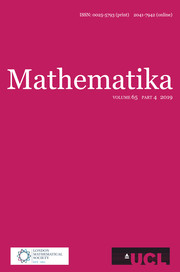Article contents
EXPONENTIAL SUMS OVER PRIMES IN SHORT INTERVALS AND AN APPLICATION TO THE WARING–GOLDBACH PROBLEM
Published online by Cambridge University Press: 17 February 2016
Abstract
Let  ${\rm\Lambda}(n)$ be the von Mangoldt function,
${\rm\Lambda}(n)$ be the von Mangoldt function,  $x$ be real and
$x$ be real and  $2\leqslant y\leqslant x$ . This paper improves the estimate for the exponential sum over primes in short intervals
$2\leqslant y\leqslant x$ . This paper improves the estimate for the exponential sum over primes in short intervals  $$\begin{eqnarray}S_{k}(x,y;{\it\alpha})=\mathop{\sum }_{x<n\leqslant x+y}{\rm\Lambda}(n)e(n^{k}{\it\alpha})\end{eqnarray}$$
$$\begin{eqnarray}S_{k}(x,y;{\it\alpha})=\mathop{\sum }_{x<n\leqslant x+y}{\rm\Lambda}(n)e(n^{k}{\it\alpha})\end{eqnarray}$$ $k\geqslant 3$ for
$k\geqslant 3$ for  ${\it\alpha}$ in the minor arcs. When combined with the Hardy–Littlewood circle method, this enables us to investigate the Waring–Goldbach problem concerning the representation of a positive integer
${\it\alpha}$ in the minor arcs. When combined with the Hardy–Littlewood circle method, this enables us to investigate the Waring–Goldbach problem concerning the representation of a positive integer  $n$ as the sum of
$n$ as the sum of  $s$
$s$  $k$ th powers of almost equal prime numbers, and improve the results of Wei and Wooley [On sums of powers of almost equal primes. Proc. Lond. Math. Soc. (3) 111(5) (2015), 1130–1162].
$k$ th powers of almost equal prime numbers, and improve the results of Wei and Wooley [On sums of powers of almost equal primes. Proc. Lond. Math. Soc. (3) 111(5) (2015), 1130–1162].
MSC classification
Information
- Type
- Research Article
- Information
- Copyright
- Copyright © University College London 2016
References
- 10
- Cited by

